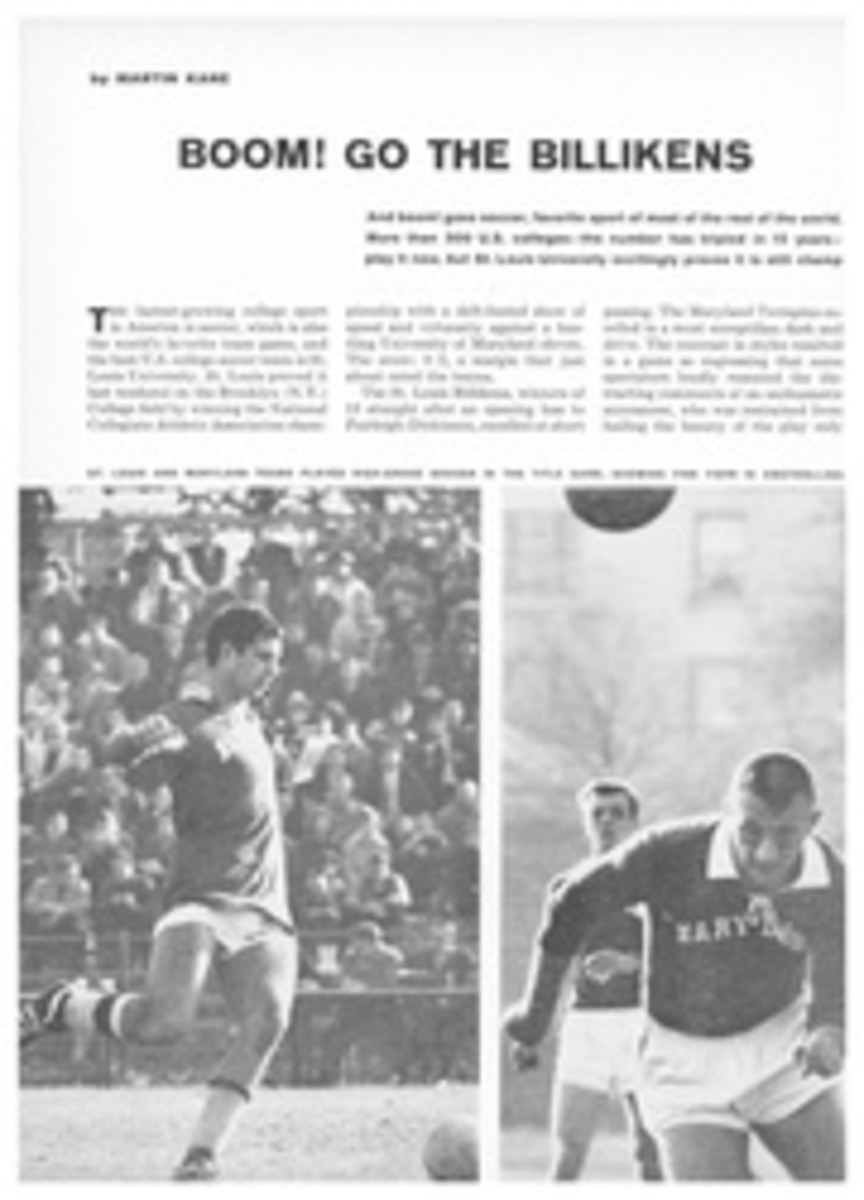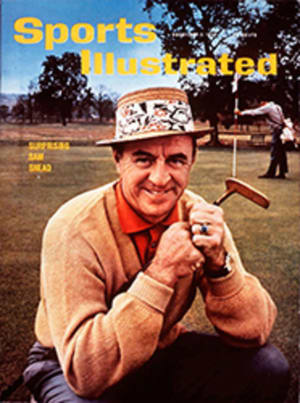
A DOUBLE DOUBLE FOR ALLEN
Allen Lawrence is a runner who insists that his track ambitions were extinguished by a dismal showing at the Olympic Games. Now, Allen Lawrence says, he is merely "going through the actions" to complete the obligations of his college athletic scholarship. For an extinguished trackman, the tidy little Australian with the immaculate stride did some pretty magnificent running last week. At East Lansing, Mich. the 28-year-old University of Houston junior carried off the National Collegiate cross-country championship for the second consecutive year. Then three days later in Louisville he won the National AAU title for the second straight time. It was the first time anyone had ever captured both titles two years in a row. He also led his four Houston running mates (two fellow Australians, one Pole and one Scot) to both team titles. It wasn't the first time a cross-country team had won both championships in the same year—Michigan State did it in 1948—but it was the first all-foreign team to do it. With an average age of 26, it was certainly the oldest team to do it.
The year between cross-country championships had been a hectic one for Lawrence. It began gloriously during the winter board season with world indoor records for two and three miles (SI, Feb. 29). It continued gloriously through the spring when he ran a solo 10,000-meter race in a U.S. record 29:36.4 (SI, March 14) as part of an effort to convince Australian Olympic selectors that he should be named to the Australian Olympic team (he was). It ended on a note of shocking and bitter disappointment during the Summer Olympics in Rome. There he failed to make the 5,000-meter final, failed to finish in the 10,000 meters and had to walk the last two miles of the marathon.
"There was never anything I could put my finger on," said Lawrence, referring to his Olympic failures. "I was able to run about 140 miles a week in training for the Games, but I always felt a bit sluggish, a bit tired. I assumed that when I started tapering off a bit just prior to the Games I'd start feeling fresh and eager again. But I never did. When I was eliminated in my 5,000 heat it took the confidence right out of me. I was a beaten man before I even lined up for the start of the 10,000. I've been in this game a long time, and I've taken some terrible thrashings before, but this was the biggest disappointment I've ever felt. It's embarrassing to carry the colors of your country in a race and then do so badly. I had my chance in the Olympics to prove that I was a world-class runner, and I couldn't do it. It's sobered me up. I've finally realized that I'm just not up to those guys. I know I can't be a world-class runner, so I'm satisfied to be just a good college or AAU runner. I've found now that I'm a much better student and that I can start planning my future life. Of course, I still have my own pride and will do just as well as I can in anything I'm in."
Thus sobered, Lawrence returned to the Houston campus this fall and, with the residue of his long summer's training still sticking to him, prepared for the cross-country season. The budget for track at Houston—a budget which includes, among other items, Coach Johnny Morriss' salary and 11 track scholarships—is a skimpy $27,500. Lawrence might have been able to work out a more profitable deal for himself elsewhere, but Houston and Coach Morriss were highly recommended by friends in the U.S. Besides, he wanted to take a radio and TV course (which Houston has) and be able to run in a climate similar to his native Sydney (which Houston has also). The other Australians followed right along. In order to stretch the few dollars available the team travels everywhere in a bright blue 1955 Plymouth station wagon, fitted over the rear seats with a wide innerspring mattress. This rolling hotel room is called the Blue Goose. Into the Blue Goose for last week's trip were squeezed Lawrence, Coach Morriss, John Macy, 30, a Polish refugee who will become an American citizen in March, Barrie Almond, 25, from Sydney, Pat Clohessy, 26, from just north of Sydney, George Rankin, 24, from Edinburgh, and Geoff Walker, a freshman from Australia just along for the ride and the experience.
If the Houston team was cramped and weary after its long trek north in the Blue Goose, this was not at all apparent to its NCAA opponents. Lawrence, his bright red uniform visible from every point on the course, broke into the lead at the half-mile point. Macy, 30 yards behind, followed him through the mile in 4:37, the two-mile in 9:38. The few ambitious collegians who tried to stay with that rapid pace had trouble even finishing. Lawrence came across the line first, covering the four miles in a course record 19:28.2. Macy was second, 75 yards back. Almond finished eighth, Clohessy 11th. When Rankin trotted across the finish line 37th among those eligible for the team scoring Houston had won its first NCAA team title.
"I'm just not ready for those guys yet," gasped Brown's Bobby Lowe after the race. The East's top runner, Lowe had won the Heptagonal, New England and IC4A titles before coming west to challenge the Houston runners. He had stayed with them for more than a mile but eventually struggled in 23rd. "Their pace was much too fast for me, it wore me out."
Exactly 71 hours later the same red-clad Houston runners were at Bellarmine College in Louisville leaning over the starting line at the National AAU race. Houston as a team faced no real challenge, but Lawrence in the individual race would be strongly opposed by U.S. Olympians Max Truex, Deacon Jones, Phil Coleman, teammate John Macy, who had won this race in 1957 and '58 and an unusual little Englishman named Fred Norris. Norris is 5 feet 6, weighs 118 pounds and is 39 years old. He also is a freshman at McNeese State College in Lake Charles, La. Until this fall Norris was a Lancashire, England coal mine maintenance worker and one of Europe's fastest road and cross-country runners. An astonishingly long recruiting arm had drawn Norris from the north of England to the bayou country of southern Louisiana. He emigrated to Lake Charles, where he had been offered a job, and then accepted a scholarship to McNeese. He had already raced against Lawrence in two dual meets, defeating him once. His eyes are widespread and deep-set, and during a race he looks like a running cadaver. Lawrence knew Norris would set an exhaustingly fast pace; his job would be to stay with him.
The cross-country course at Bellarmine winds through a superb natural amphitheater. High, grassy slopes sweep up from the large plain formed by the college's athletic fields where the race begins and ends. After chugging up a steep hill that takes them out of the starting area, the runners disappear behind the college buildings, then appear again on the right, weaving through the hillocks and valleys that compose Bellarmine's small nine-hole golf course.
A crowd of 4,000, unusually large for this lightly attended sport, was on hand. Norris sped away from the pack of 61 runners at the start, and Lawrence doggedly stuck right with him. They raced through the first mile of the 6-mile course in just a shade over 4:30, then stayed shoulder to shoulder for the next 4½ miles, pulling farther and farther ahead of the field. Finally they broke out onto the large plain for the final half loop around to the finish line, about 800 yards away. They raced along the far side of the baseball field, onto the cinder track, then around and back toward the crowd packed around the finish. With 150 yards to go, Lawrence suddenly sprinted ahead. Grimacing with the pain of the effort, teeth clenched, his head bobbing frantically, he plunged through the tape to beat Norris by 40 yards in a time of 31:20.8. Houston easily won the team championship with 33 points to the runner-up New York AC's 42.
"I couldn't have run any faster," said runner-up Norris, "and I thought I had him at about four miles when he fell back a yard or so. But he came right back again."
"I couldn't have run any faster," said winner Lawrence, "and if he'd been able to keep up that pace a bit longer he would have beaten me. But he slowed up a little in the last half mile. I had just enough left to win."
Three hours after the race the Blue Goose sat outside a downtown Louisville hotel, overstuffed but ready to fly. Its cargo included one coach, one freshman who ran at Louisville unattached, nine bulging, oversized traveling grips, four wardrobe bags, one innerspring mattress, eight large trophies, 17 medals and five exhausted but content Houston runners. On the curb stood John Gutknecht, a boyish-looking graduate student in zoology at North Carolina. Gutknecht had surprised himself by finishing third in the AAU race and had been surprised to learn that as the first U.S. citizen to finish he had earned a trip to Brazil for a New Year's Eve road race in Sao Paulo. Now he was in for another surprise.
"My God," he said in astonishment, as the loaded station wagon pulled away. "They're all really going home in that thing. They told me they were, but I thought they were pulling my leg."
PHOTO
HY PESKIN
HEAD THROWN BACK, KNEES KICKING HIGH, HOUSTON'S AL LAWRENCE SPRINTS ACROSS FINISH LINE AT AAU RACE IN LOUISVILLE
PHOTO
HY PESKIN
MOST OF THE AAU FIELD (RIGHT) WAS STILL GOING THAT AWAY AS NORRIS (IN WHITE) AND LAWRENCE HEADED TOWARD FINISH
PHOTO
HY PESKIN
CROSS-COUNTRY RUNNERS Clohessy (left), Walker, Lawrence, Almond, Rankin dress beside team's station wagon after AAU race. Houston Coach Morriss looks on.

